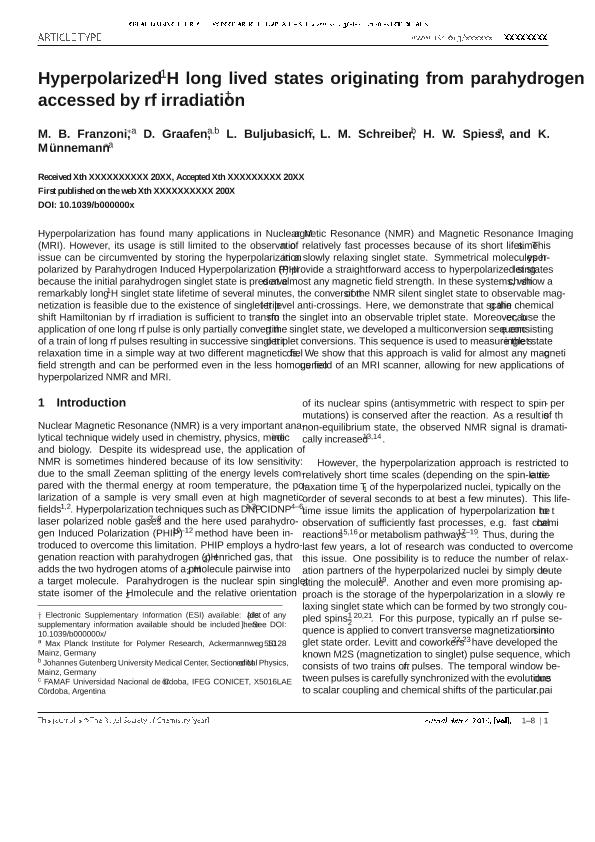Mostrar el registro sencillo del ítem
dc.contributor.author
Franzoni, Maria Belen

dc.contributor.author
Graafen, D.
dc.contributor.author
Buljubasich Gentiletti, Lisandro

dc.contributor.author
Schreiber, L. M.
dc.contributor.author
Spiess, H. W.
dc.contributor.author
Münnemann, K.
dc.date.available
2017-10-05T20:01:57Z
dc.date.issued
2013-09
dc.identifier.citation
Franzoni, Maria Belen; Graafen, D.; Buljubasich Gentiletti, Lisandro; Schreiber, L. M.; Spiess, H. W.; et al.; Hyperpolarized 1H long lived states originating from parahydrogen accessed by rf irradiation; Royal Society of Chemistry; Physical Chemistry Chemical Physics; 15; 40; 9-2013; 17233-17239
dc.identifier.issn
1463-9076
dc.identifier.uri
http://hdl.handle.net/11336/26032
dc.description.abstract
Hyperpolarization has found many applications in Nuclear Magnetic Resonance (NMR) and Magnetic Resonance Imaging (MRI). However, its usage is still limited to the observation of relatively fast processes because of its short lifetimes. This issue can be circumvented by storing the hyperpolarization in a slowly relaxing singlet state. Symmetrical molecules hyperpolarized by Parahydrogen Induced Hyperpolarization (PHIP) provide a straightforward access to hyperpolarized singlet states because the initial parahydrogen singlet state is preserved at almost any magnetic field strength. In these systems, which show a remarkably long 1H singlet state lifetime of several minutes, the conversion of the NMR silent singlet state to observable magnetization is feasible due to the existence of singlet-triplet level anti-crossings. Here, we demonstrate that scaling the chemical shift Hamiltonian by rf irradiation is sufficient to transform the singlet into an observable triplet state. Moreover, because the application of one long rf pulse is only partially converting the singlet state, we developed a multiconversion sequence consisting of a train of long rf pulses resulting in successive singlet to triplet conversions. This sequence is used to measure the singlet state relaxation time in a simple way at two different magnetic fields. We show that this approach is valid for almost any magnetic field strength and can be performed even in the less homogeneous field of an MRI scanner, allowing for new applications of hyperpolarized NMR and MRI.
dc.format
application/pdf
dc.language.iso
eng
dc.publisher
Royal Society of Chemistry

dc.rights
info:eu-repo/semantics/openAccess
dc.rights.uri
https://creativecommons.org/licenses/by-nc-sa/2.5/ar/
dc.subject
Long Lived States
dc.subject
Hyperpolarization
dc.subject
Parahydrogen
dc.subject
Phip
dc.subject.classification
Otras Ciencias Físicas

dc.subject.classification
Ciencias Físicas

dc.subject.classification
CIENCIAS NATURALES Y EXACTAS

dc.title
Hyperpolarized 1H long lived states originating from parahydrogen accessed by rf irradiation
dc.type
info:eu-repo/semantics/article
dc.type
info:ar-repo/semantics/artículo
dc.type
info:eu-repo/semantics/publishedVersion
dc.date.updated
2017-10-03T18:22:45Z
dc.journal.volume
15
dc.journal.number
40
dc.journal.pagination
17233-17239
dc.journal.pais
Reino Unido

dc.description.fil
Fil: Franzoni, Maria Belen. Max Planck Institute for Polymer Research; Alemania. Consejo Nacional de Investigaciones Científicas y Técnicas; Argentina
dc.description.fil
Fil: Graafen, D.. Max Planck Institute for Polymer Research; Alemania. Johannes Gutenberg University Medical Center; Alemania
dc.description.fil
Fil: Buljubasich Gentiletti, Lisandro. Consejo Nacional de Investigaciones Científicas y Técnicas. Centro Científico Tecnológico Conicet - Córdoba. Instituto de Física Enrique Gaviola. Universidad Nacional de Córdoba. Instituto de Física Enrique Gaviola; Argentina
dc.description.fil
Fil: Schreiber, L. M.. Johannes Gutenberg University Medical Center; Alemania
dc.description.fil
Fil: Spiess, H. W.. Max Planck Institute for Polymer Research; Alemania
dc.description.fil
Fil: Münnemann, K.. Max Planck Institute for Polymer Research; Alemania
dc.journal.title
Physical Chemistry Chemical Physics

dc.relation.alternativeid
info:eu-repo/semantics/altIdentifier/doi/http://dx.doi.org/10.1039/C3CP52029C
dc.relation.alternativeid
info:eu-repo/semantics/altIdentifier/url/http://pubs.rsc.org/-/content/articlelanding/2013/cp/c3cp52029c/unauth#!divAbstract
Archivos asociados
